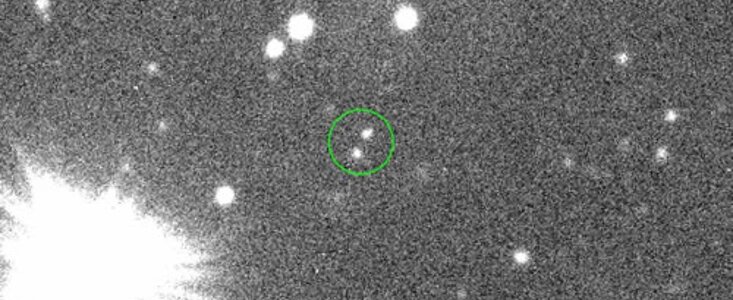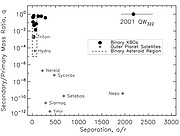A Highly-split Kuiper Belt Pair
28 October 2008
A group of astronomers using a battery of 8-meter telescopes, including both Gemini North and South, have discovered a small pair of gravitationally bound Kuiper Belt objects with an enormous separation (Figure 1). The extreme binary, 2001 QW322, orbits at 43 astronomical units or about 6.5billion kilometers from the Sun. The two bodies are separated by about 125,000 kilometers (one third the distance from the Earth to the Moon) which is very large for these two tiny bodies. As a comparison, this is approximately equivalent to a pair of baseballs gravitationally "connected" and orbiting each other at a distance of 200 kilometers!
2001 QW322 was discovered in August 2001 with the Canada-France-Hawai‘i Telescope. Since then, (from 2002-2007), the pair has been monitored closely using 8-meter-class telescopes (Gemini North,Gemini South and the European Southern Observatory’s Very Large Telescope) to obtain high precision photometric observations of the faint double system (mg = 24).
There are on the order of about a billion additional Kuiper Belt Objects in our solar system with Pluto and Charon being among the largest members of this important group of minor planets. These small icy bodies move in low eccentricity and low inclination orbits beyond Neptune, extending possibly as far as 1,000 times the distance from the Earth to the Sun. Predicted independently about 60 years ago by American astronomers Kenneth Edgeworth and Gerard Kuiper, the first Kuiper Belt objects were discovered by David Jewitt and Jane Luu in August 1992. Since them the number of known objects has exploded.
Most Kuiper Belt Objects are single objects. The advent of adaptive optics and various survey techniques has created a surge in the discovery of binaries in the main asteroid and Kuiper belts. Measurements of the frequency of binary objects, their sizes and orbital configurations will help to constrain their formation and evolution, theories of planetesimal accretion and disruption, and the collisional history of the Kuiper Belt. Pairs are also the only way to derive the mass and density of these objects. 2001 QW322 clearly stands out as the widest orbit, near-equal mass binary of the solar system (Figure 2).
This investigation by a large international team led by J.-M. Petit of Observatoire de Besançon is a striking example of how researchers pull together the observing and instrument capabilities of several telescopes (in this case Gemini North and South, CFHT, VLT and the Multi-Mirror Telescope) to follow objects, monitor events or conduct large observing programs. This efficient multi-telescope research is enabled by large and well-coordinated teams. This approach is used more and more, combining either ground-based telescopes in the same or different wavelength regimes and by coordinating space- with ground-based observatories.
Links
“The Extreme Kuiper Belt Binary 2001 QW322” in Science, vol. 322, pp. 432-434 (17 October 2008) or visit the discovery team’s web site at: www.cfeps.net



